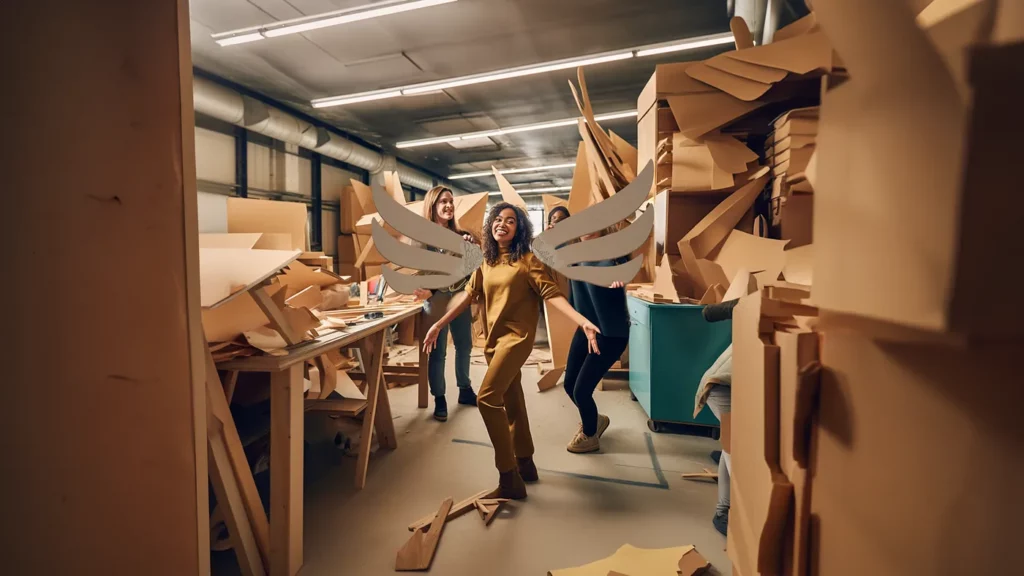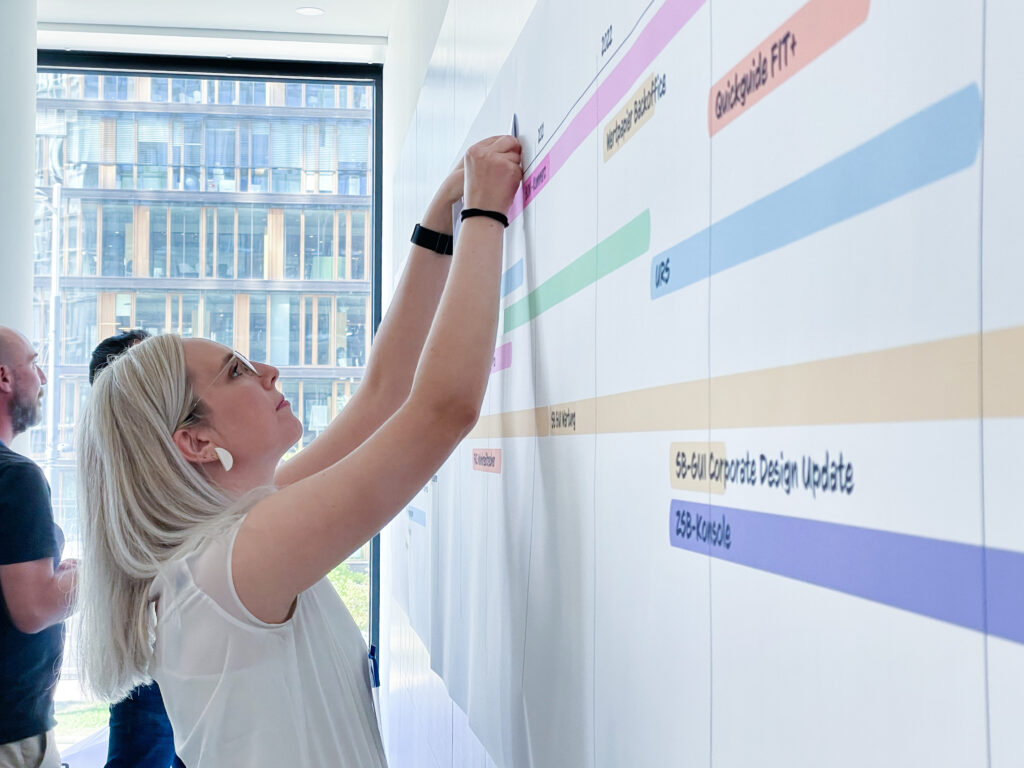Teamwork
Focused teamwork
by Philipp Brunner
(revised) 08.03.2024
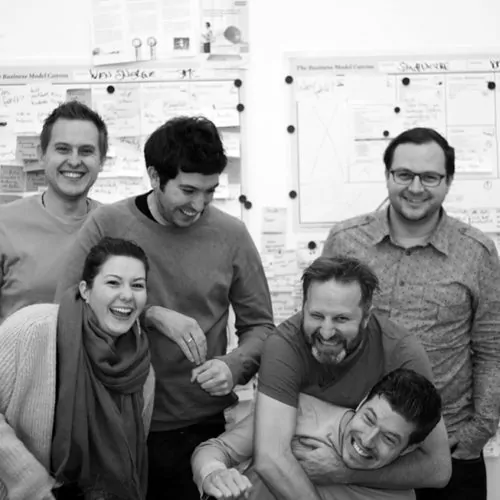
For the dmcgroup, as for many other agencies in the digital and advertising sector, taking part in project tenders – known as “pitches” in agency parlance – is an important method for new business development. The time to prepare a pitch submission is short. Teamwork methods are therefore required to achieve maximum creativity and productivity in a short space of time.
The dmcgroup in the War Room: Ingredients for teamwork with focus – for maximum output (and fun)
The dmcgroup has tested and established a new set of methods for focused teamwork and output maximization on the occasion of a pitch participation. The subject of the pitch was the redesign of several portal sites of a municipal company.
Dedicated space – a “New Business War Room”
The project team has to get to grips with a complex topic in a very short space of time and therefore needs an environment that offers little external distraction and sufficient space for project work. The term “war room” has been used for some time as a martial but apt description of such a project environment:
A War Room (or command center) is any place that is used to provide centralized command for some purpose.
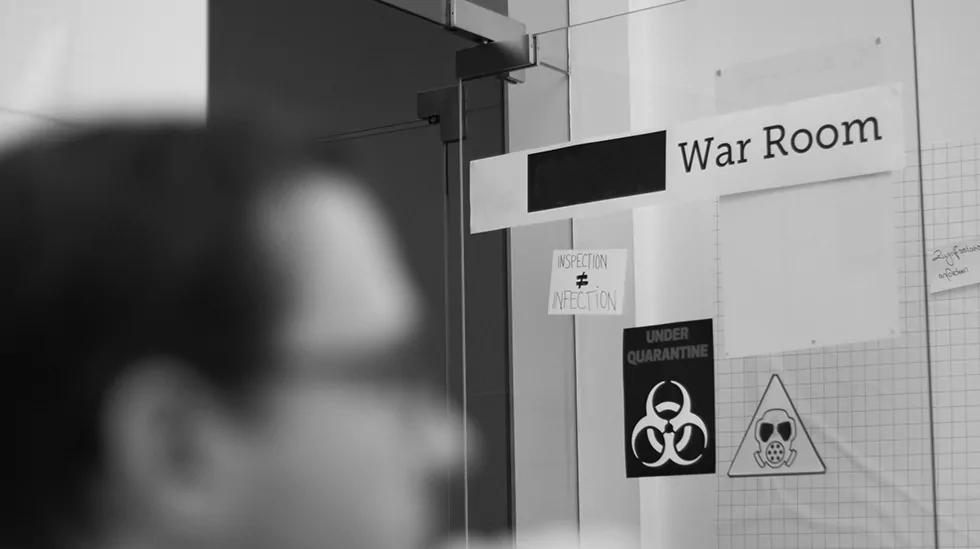
The decisive criterion for a good war room is its flexibility and adaptability: different work steps and groups require different spatial set-ups and workstations. Also important: free walls or boards for sketches, notes and thoughts (more on this below). Depending on the task, different “trades” and teams are involved in the work in the project space.
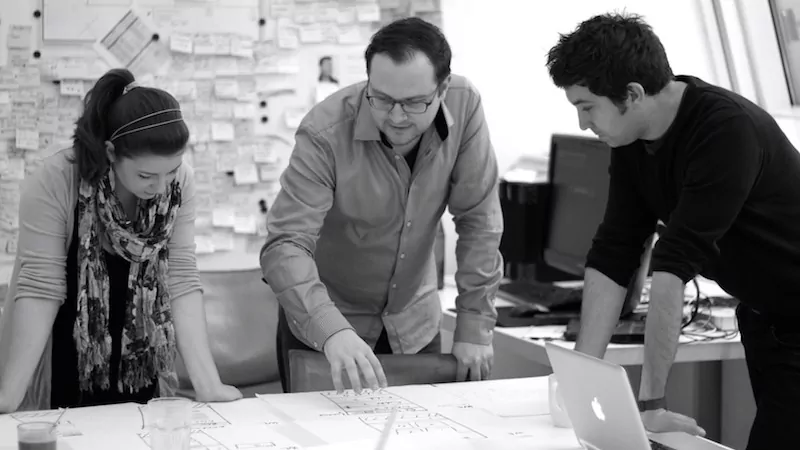
The pulse of the project: Daily Huddles
Daily huddles are daily (mainly in the morning), short and concise meetings on the project status. Originally a method from agile software development, stand-up meetings and huddles have long since arrived in the agency sector.
The term “huddle” is borrowed from the world of sport: in American football, the huddle is known as a joint meeting of the players of a team at the start of a game to discuss strategy and moves. The players literally put their heads together.
In the agency context, the huddle also serves to discuss the “actions and moves” as well as the overarching strategy for the day. The huddle offers some essential benefits for project work and the team:
- The team collaboratively develops the procedure for the day
- Existing information, knowledge, solutions and problems are shared within the team
- This can ensure a common understanding of things
- In this way, errors or problems can be detected and avoided at an early stage
Huddles are an excellent way to activate a team for the day ahead because they are personal meetings – direct “face to face” communication and strengthening the “we” spirit in the project team are paramount. In the course of our pitch project, the daily huddles proved to be an extremely effective way to start the working day.
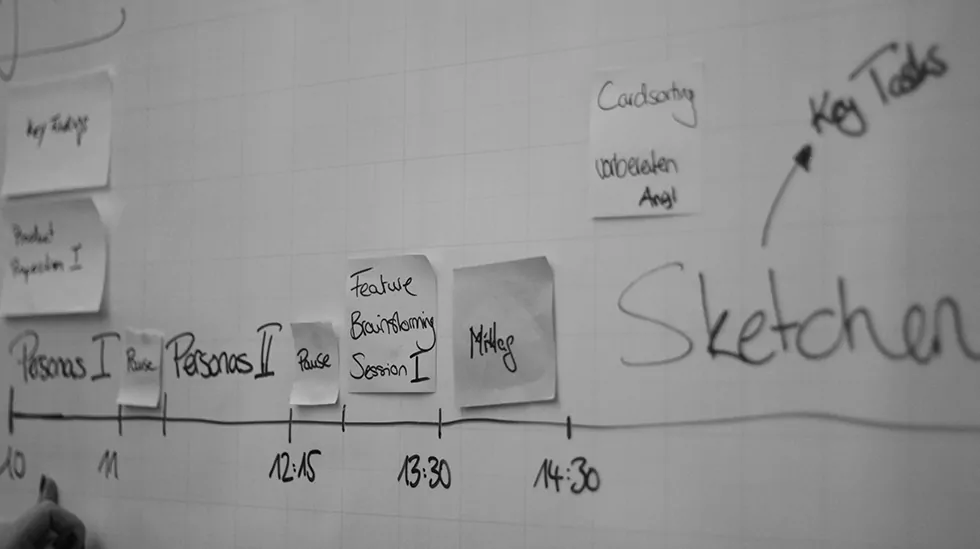
A room full of ideas – Wallspace & Post-Its
As mentioned earlier, a room with lots of free, playable walls (i.e. available “wall space”) is a valuable ingredient for an inspiring project space.
By pinning as many working principles and results as possible on the walls, such as project goals, keywords for the client’s business models, tag clouds with relevant concept ideas, sketches or final screens, the team always has them in front of them. Nothing can get lost and any deviations from the developed concept are immediately apparent.
There were three project phases in the course of our work on the pitch:
- Gamestorming & Innovation Games: The first step was to use playful innovation techniques to understand the tasks, work out business and user goals and develop a joint project vision.
- Definition & conception: In the next step, we separated important findings from less important ones, developed story maps and user tasks for the relevant user groups (user-centered design) and outlined our ideas. The definition of key elements helped to further focus the project vision.
- Design, prototyping & presentation: Wireframes served as the basis for the creative realization of the vision by our designers. A click dummy and a multimedia-enriched presentation were prepared for the pitch meeting.
In all phases, it helped to always have the entirety of our project vision in front of us – on the walls. We had to use ladders towards the end of the pitch process to be able to use the last available wall space.
Learn
more
We are more than just experts – our dedicated team of designers, developers and marketing specialists work hand in hand to take your digital presence to the next level.
Ready for the next step?
Contact us and find out more about our services.
Mood monitor for the team – Mini-Retro & Retro
Two weeks of concentrated teamwork is a long time – and an emotional challenge for every team. Open communication is therefore essential at all times during the course of the project.
The retrospective method is used particularly in agile software development. It is a team meeting in which we discuss what went well in the course of the project work and is of value to be established in our further working methods. The retrospective also addresses things that were not conducive to the project work and should be avoided in future. We also analyze which things should be adjusted to improve the way we work.
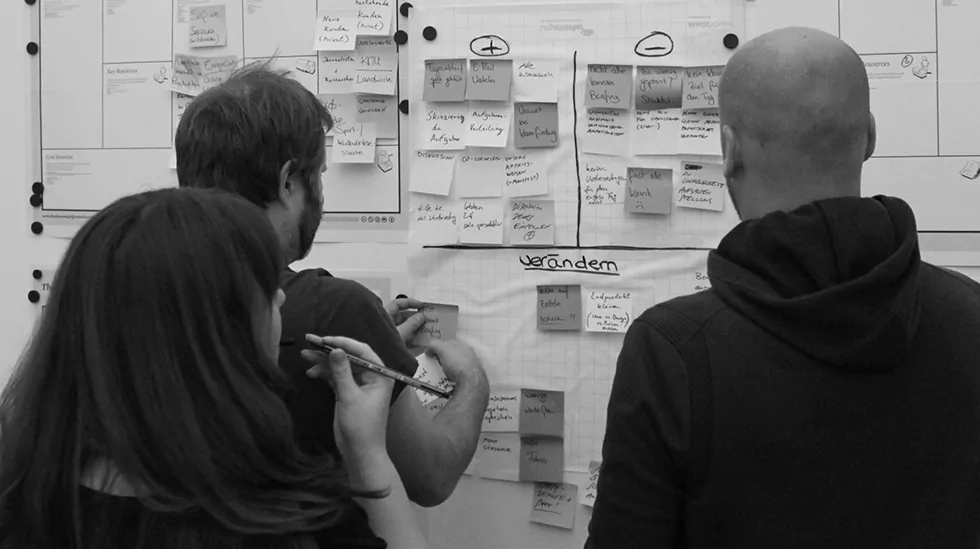
In the context of intensive teamwork for a pitch submission, daily mini-retros (no longer than 15 minutes at the end of each working day) prove to be an important tool for reacting promptly to problems that arise and keeping the team motivated. The mini-retros ensure a common understanding in the project and improve communication, safety and quality.
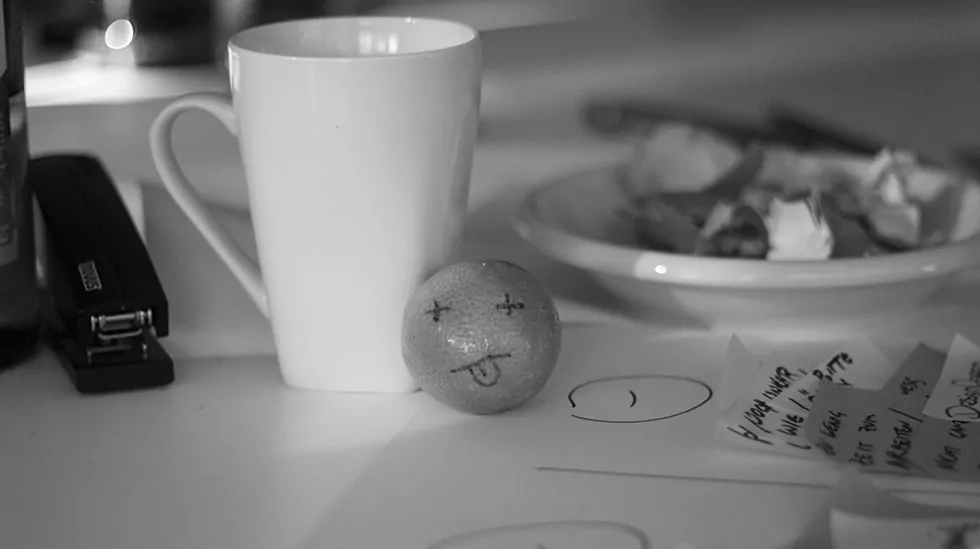
After the presentation of the pitch project, a special form of retrospective was chosen: the “Emotional Seismograph”. The aim of the exercise is to find out which events have triggered certain emotions. She helped the team to better understand the many changes and adjustments within the project and the effects on the mood within the team.
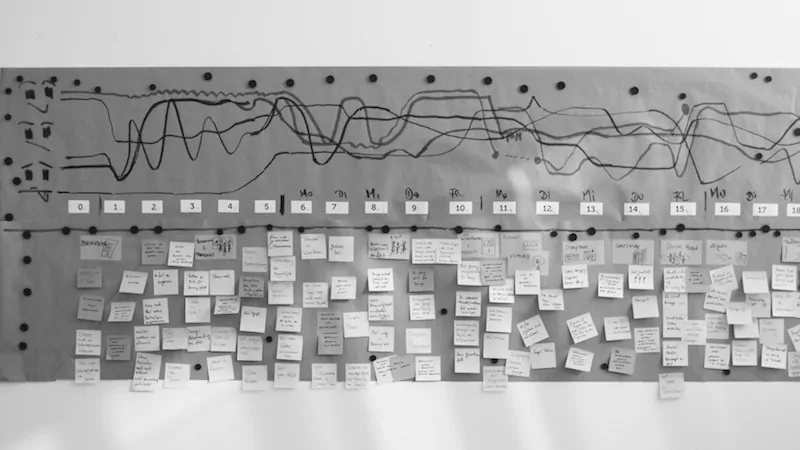
In most cases, it is very difficult to have a discussion about feelings and sensations. The “Emotional Seismograph” slowly leads the team there. It shows when and how similar sensitivities arise in the group. This makes it easier for individuals to talk about their impressions, as similarities are immediately visible. In addition, patterns of working methods or actions were identified with which the team was able to work successfully and those which it would like to exclude or avoid in the future. The findings have been incorporated into our daily work and are still valid today.
Conclusion
In the end, everyone involved in the pitch project agreed that this form of structured and focused collaboration is highly productive and a lot of fun. The motivation in the project was very high throughout (apart from temporary fluctuations), the team identified with the project and had a completely new experience of teamwork over the course of the project.
Incidentally, the dmcgroup did not win the pitch. The team still stands behind the concept and design developed and the process in which they were created.
Book recommendations
- Business Model Generation: A Handbook for Visionaries, Game Changers, and Challengers
By Alexander Osterwalder and Yves Pigneur - Visual Teams: Graphic Tools for Commitment, Innovation, and High Performance
By David Sibbet - Agile Retrospectives: Making Good Teams Great
by Esther Derby and Diana Larsen
Foreword by Ken Schwaber
From the latest industry trends and the latest insights into AI and UX/UI design to exciting use cases.
Sign up for our monthly newsletter and stay up to date!
Stay
tuned
More articles

